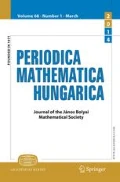Abstract
For the Fibonacci sequence the identity \(F_n^2+F_{n+1}^2 = F_{2n+1}\) holds for all \(n \ge 0\). Let \({\mathcal {X}}:= (X_\ell )_{\ell \ge 1}\) be the sequence of X-coordinates of the positive integer solutions (X, Y) of the Pell equation \(X^2-dY^2=\pm 1\) corresponding to a nonsquare integer \(d>1\). In this paper, we investigate all positive nonsquare integers d for which there are at least two positive integers X and \(X'\) of \(\mathcal {X}\) having a representation as the sum of xth powers of two consecutive terms of a Lucas sequence. Then we solve this problem for Fibonacci numbers.
Similar content being viewed by others
Notes
The k-generalized Fibonacci sequence \(F^{(k)}\), for an integer \(k\ge 2\), satisfies that its first k terms are \(0, \ldots , 0, 1\) and each term afterwards is the sum of the preceding k terms. For \(k = 2\), this reduces to the familiar Fibonacci numbers, while for \(k = 3\) these are the Tribonacci numbers. They are followed by the Tetranacci numbers for \(k = 4\), and so on.
For a positive integer base \(b \ge 2\), a repdigit is a positive integer N whose base b-representation has a unique repeating digit.
References
D. Marques, A. Togbé, On the sum of powers of two consecutive Fibonacci numbers. Proc. Japan Acad. Ser. A Math. Sci. 86(10), 174–176 (2010)
F. Luca, R. Oyono, An exponential Diophantine equation related to powers of two consecutive Fibonacci numbers. Proc. Japan Acad. Ser. A Math. Sci. 87(4), 45–50 (2011)
A.P. Chaves, D. Marques, A Diophantine equation related to the sum of squares of consecutive \(k\)-generalized Fibonacci numbers. Fibonacci Quart. 52(1), 70–74 (2014)
C.A. Gómez, F. Luca, An exponential Diophantine equation related to the sum of powers of two consecutive \(k\)-generalized Fibonacci numbers. Colloq. Math. 137(2), 171–188 (2014)
D. Bednařík, G. Freitas, D. Marques, P. Trojovský, On the sum of squares of consecutive \(k\)-bonacci numbers which are \(l\)-bonacci numbers. Colloq. Math. 156(1), 153–164 (2019)
A.P. Chaves, D. Marques, A. Togbé, On the sum of powers of terms of a linear recurrence sequence. Bull. Braz. Math. Soc. (N.S.) 43, 397–406 (2012)
Z. Şiar, An exponential Diophantine equation related to the difference of powers of two Fibonacci numbers, (2020), arXiv:2002.03783
M. Ddamulira and F. Luca, On the exponential Diophantine equation related to powers of two consecutive terms of Lucas sequences, (2020), To appear in: The Ramanujan Journal
S.E. Rihane, B. Faye, F. Luca, A. Togbé, An exponential diophantine equation related to the difference between powers of two consecutive balancing numbers. Ann. Math. Inform. 50, 167–177 (2019)
S.E. Rihane, B. Faye, F. Luca, A. Togbé, On the exponential Diophantine equation \(P^x_n+P^x_{n+1}=P_m\). Turkish J. Math. 43(3), 1640–1649 (2019)
W. Ljunggren, Zur Theorie der Gleichung \(x^2+1=Dy^4\). Avh. Norske Vid. Akad. Oslo. I. 1942(5), 27 (1942)
J.H.E. Cohn, The Diophantine equation \(x^4-Dy^2=1\). II, Acta Arith. 78(4), 401–403 (1997)
A. Dossavi-Yovo, F. Luca, A. Togbé, On the \(x\)-coordinates of Pell equations which are rep-digits. Publ. Math. Debrecen 88(3–4), 381–399 (2016)
B. Faye, F. Luca, On \(X\)-coordinates of Pell equations that are repdigits. Fibonacci Quart. 56(1), 52–62 (2018)
F. Luca, A. Togbé, On the \(x\)-coordinates of Pell equations which are Fibonacci numbers. Math. Scand. 122(1), 18–30 (2018)
M. Ddamulira, F. Luca, On the \(x\)-coordinates of Pell equations which are \(k\)-generalized Fibonacci numbers. J. Number Theory 207, 156–195 (2020)
C.A. Gómez, F. Luca, Zeckendorf representations with at most two terms to \(X\)-coordinates of pell equations. Sci. China Math. 62(2019). https://doi.org/10.1007/s11425-017-9283-6
E.F. Bravo, C.A. Gómez, F. Luca, \(X\)-coordinates of Pell equations as sums of two tribonacci numbers. Period. Math. Hungar. 77(2), 175–190 (2018)
E.F. Bravo, C.A. Gómez, F. Luca, Correction to: X-coordinates of Pell equations as sums of two Tribonacci numbers. Period. Math. Hungar. 80(1), 145–146 (2020)
B. Kafle, F. Luca, A. Montejano, L. Szalay, A. Togbé, On the \(X\)-coordinates of Pell equations which are products of two Fibonacci numbers. J. Number Theory 203, 310–333 (2019)
E.M. Matveev, An explicit lower bound for a homogeneous rational linear form in logarithms of algebraic numbers. II. Izv. Ross. Akad. Nauk Ser. Mat. 64(6), 125–180 (2000)
A. Pethö, B.M.M. de Weger, Products of prime powers in binary recurrence sequences part i: The hyperbolic case, with an application to the generalized ramanujan-nagell equation. Math. Comput. 47(176), 713–727 (1986)
B.M.M. de Weger, Algorithms for diophantine equations, vol. 239 (Amsterdam, Netherlands, 1987)
A. Dujella, A. Pethö, A generalization of a theorem of Baker and Davenport. Quart. J. Math. Oxford Ser. (2) 49(195), 291–306 (1998)
H. Cohen, Number theory Vol. I. Tools and Diophantine equations. Graduate texts in mathematics, vol. 239 (Springer, New York, 2007)
Y. Bilu, G. Hanrot, P.M. Voutier, Existence of primitive divisors of Lucas and Lehmer numbers, J. Reine Angew. Math. 539: 75–122 (With an appendix by M, Mignotte, 2001)
Acknowledgements
We thank the referee for a careful reading of the manuscript and for several suggestions which improved the presentation of our paper. The first author was partially supported by CAPES while C. A. G. was supported in part by Project 71280 (Universidad del Valle).
Author information
Authors and Affiliations
Corresponding author
Additional information
Publisher's Note
Springer Nature remains neutral with regard to jurisdictional claims in published maps and institutional affiliations.
Rights and permissions
About this article
Cite this article
Erazo, H.S., Gómez, C.A. An exponential Diophantine equation related to the sum of powers of two consecutive terms of a Lucas sequence and x-coordinates of Pell equations. Period Math Hung 83, 165–184 (2021). https://doi.org/10.1007/s10998-021-00388-9
Accepted:
Published:
Issue Date:
DOI: https://doi.org/10.1007/s10998-021-00388-9


